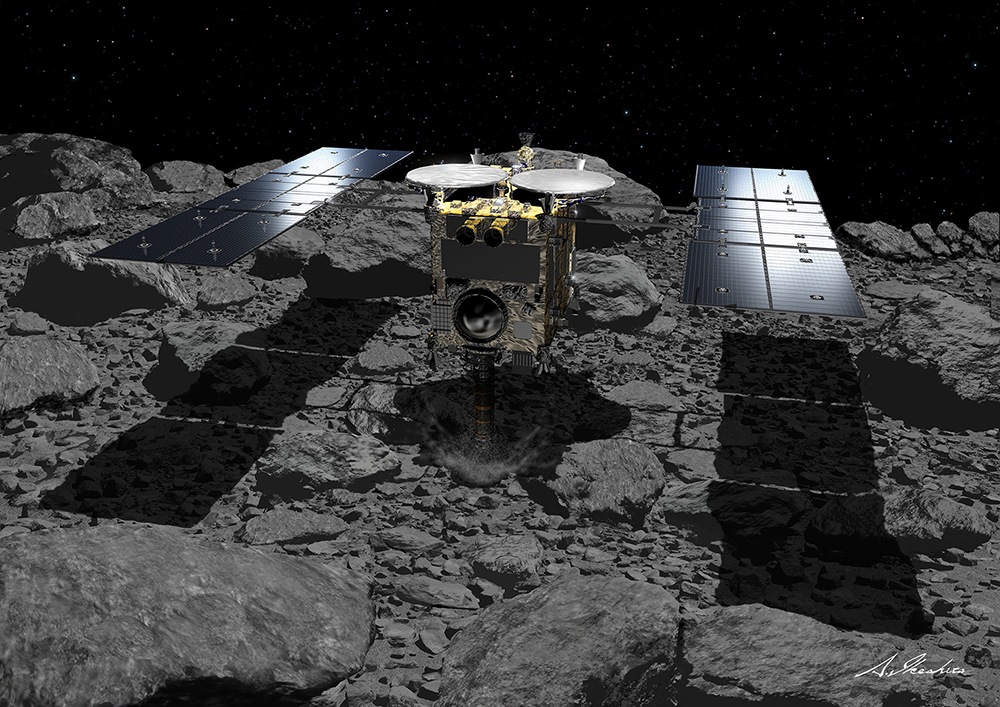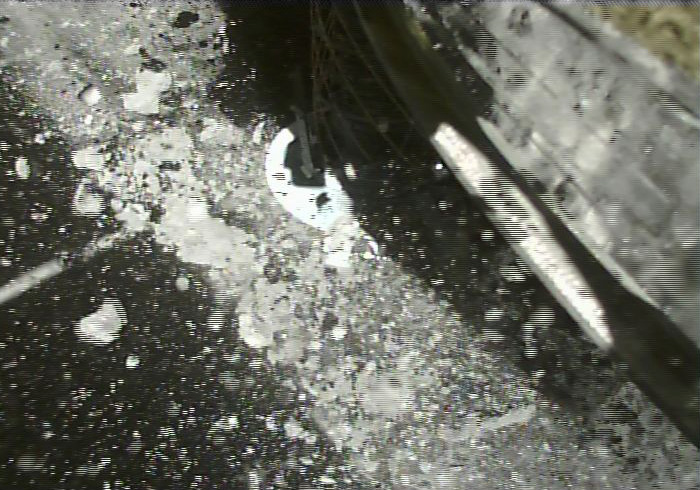
“1… 2… 3… 4…”
The counting in the Hayabusa2 control room at the Japan Aerospace Exploration Agency’s Institute of Space and Astronautical Sciences (JAXA, ISAS) took on a rhythmic beat as everyone in the room took up the chant, their eyes fixed on the large display mounted on one wall.
“10… 11… 12… 13…”
The display showed the line-of-sight velocity (speed away from or towards the Earth) of the Hayabusa2 spacecraft. The spacecraft was about 240,000,000 km from the Earth where it was studying a near-Earth asteroid known as Ryugu. At this moment, the spacecraft was dropping to the asteroid surface to collect a sample of the rocky body.
“20… 21… 22… 23…”

Asteroid Ryugu is a carbonaceous or “C-type” asteroid; a class of small celestial bodies thought to contain organic material and undergone relatively little alteration since the beginning of the Solar System. Rocks similar to Ryugu would have pelted the early Earth, possibly delivering both water and the first ingredients for life to our young planet. Where and when these asteroids formed and how they moved through the Solar System is therefore a question of paramount importance to understanding how terrestrial planets like the Earth became habitable. It is a question not only tied to our own existence, but also to assessing the prospect of life elsewhere in the Universe.
The Hayabusa2 mission arrived at asteroid Ryugu just over one year ago at the end of June 2018. The spacecraft remotely analyzed the asteroid and deployed two rovers and a lander to explore the surface. Then in February of this year, the spacecraft performed its own descent to touchdown and collect a sample. The material gathered will be analyzed back on Earth when the spacecraft returns home at the end of 2020.
Touchdown is one of the most dangerous operation in the mission. The distances involved mean that it took about 19 minutes to communicate with the spacecraft during the first touchdown and 13 minutes during the second touchdown, when the asteroid had moved slightly closer to Earth. Both these durations are too long to manually guide the spacecraft to the asteroid surface. Instead, Hayabusa2 has to autonomously land by judging its location and altitude to high precision in order to avoid hitting the boulders strewn liberally over the treacherous terrain.
Concerns about the spacecraft safety delayed the initial touchdown from its earliest planned date in the autumn of 2018 to the start of 2019 (an event we covered here). So why if touchdown is so challenging did the team decided to do a second sample collection? An operation that potentially risked both the spacecraft and the first successfully gathered sample.

The answer lies in a mission operations that took place at the start of April. On April 5, 2019, Hayabusa2 dropped a cylindrical container packed with 9.5 kg (21 pounds) of explosive. This small carry-on impactor (SCI) accelerated a 2 kg (4.4 pound) copper plate towards the surface of Ryugu at a speed of about 2 km/s, striking the rock and forming an artificial crater.
While Ryugu’s surface is pockmarked with craters, these are old wounds from impacts during the asteroid’s long history. Since their formation, radiation from the sun, additional impacts and cosmic rays have altered the properties of the exposed material in a process known as “space weathering”. The fresh depression created by the SCI exposed material below the asteroid’s weathered surface both inside the crater and in the ejecta that was thrown outwards into the surrounding area. This freshly exposed material was darker than the asteroid surface; an impressive feat as Ryugu is darker than any other object previously visited by spacecraft.
After the generation of the artificial crater, the Hayabusa2 spacecraft performed four low sweeps over the impact area to observe the crater and ejecta. Analysis of the more pristine material from within the asteroid may be a better comparison with the meteorites that hit the early Earth, giving us a clearer picture of the ingredients landing on our planet. Examination of the crater also provides information about the asteroid’s tensile strength, revealing information about Ryugu’s history.
Yet this information is far less than what could be learned by bringing a sample of the ejecta to Earth. Even the best onboard suite of instruments are not able to perform analysis equal to that of a laboratory on Earth. Not only is laboratory equipment more extensive, but the sample can be preserved and analyzed by new equipment not yet developed. This has been the case with the Apollo samples, which are analyzed today by both equipment and scientists not built or born during the moon landings.
But a second touchdown would be no easy venture. The team therefore examined the site around the artificial crater with care to ensure the operation would be at least as safe as the first touchdown. Several large boulders close to the best landing point were unofficially named “Styx” and “small Styx” by the team as a nod to the mythological River Styx that separates the living from the dead and might here present the same crossing for the spacecraft.
On June 27, the team announced that the risk was sufficiently low to attempt the second touchdown. Not only was the potential scientific gain high, this would also be the first time material has been collected from two different areas of a celestial body and the first time subsurface material has been gathered. Not only do multiple samples avoid the chance of an anomalous site being inadvertently selected, but repeated sampling establishes the reliability of important technology for the future.
The Hayabusa2 spacecraft began its descent on July 10, dropping towards the asteroid surface at an initial speed of 40 cm/s. The following day at about 10:18 JST, Hayabusa2 began its final descent to the surface. The touchdown site was a position about 20 m from the artificial crater where ejected material appeared to have spread across the region.

“70… 71… 72… 73…”
As the long sampler horn on Hayabusa2 touched the surface of Ryugu, a bullet was fired down the horn to stir up the surface material and allow it to rise into the sample capsule.
“81… 82… 83… 84…”
In the control room, the screen displaying the velocity of the spacecraft showed the direction change as Hayabusa2 began to rise. Loud applause broke out around the room. About 20 minutes later, Hayabusa2 rotated so that the spacecraft’s high gain antenna was once again pointed at Earth, allowing data and information about the spacecraft condition to be transmitted home. The operation had gone perfectly.
“Out of 100, I’d like to give a score of 1000,” said the mission Project Manager, Yuichi Tsuda, speaking at the press conference directly after the touchdown operation. “It was a perfect operation!”
It was a success Tsuda credits to the team work of the Hayabusa2 project.
The sample capsule on Hayabusa2 has the capacity to carry three separated samples in different chambers. Once away from the asteroid surface, chamber C was rotated to slide shut, safely storing the second sample alongside the sample from the first touchdown that sits with chamber A. The third chamber will not be used for samples, as the difficult landscape on Ryugu makes it unwise to risk an additional landing. In a few weeks, the asteroid surface will also become too warm for a safe touchdown.
Images captured by the wide angle Optical Navigation Camera (ONC-W1) and the small monitor camera, CAM-H, that looks alongside the sampler horn, shows material thrown upwards during the touchdown.
“When I first saw this image for the first time, there was so much ejecta that I wondered if the catcher lid can be closed!” Project Engineer Saeki Takanao said during the press conference.
Fortunately, these concerns proved to be unfounded.
Hayabusa2 will stay examining Ryugu from orbit for another few months before beginning the journey home. It will arrive back at Earth at the end of 2020, carrying two samples that could be postcards snapped from the past of our planet and ourselves.
Fresh news from Hayabusa2 can be found on their website and twitter feed.

2 Replies to “Hayabusa2 Snatches Second Asteroid Sample”
Comments are closed.